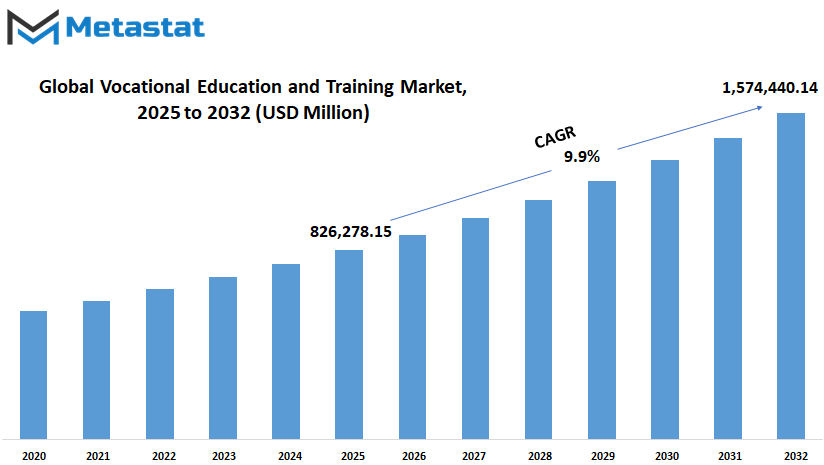MARKET OVERVIEW
The Global Vocational Education and Training market, which is based in the broader education services industry, will be a backbone for competency-based learning models that will equip individuals for particular trades, crafts, and technical professions. Unlike traditional academic pathways, this market will focus on applied competencies rather than theoretical frameworks, creating a workforce that is attuned to industry-specific functions within manufacturing, healthcare, construction, logistics, and information technology industries. Institutions, governments, and private organizations will continue to collaborate in the refinement of vocational programs to keep up with the rapidly changing needs of skilled labor.
Traditional education systems in areas will no longer deliver the specialized knowledge industry demands today. Therefore, the Global Vocational Education and Training market will be tasked with creating flexible training solutions with a focus on hands-on training and quantifiable competence. These courses will not only offer certification but create job-capable talent pipelines that can address current and future technical requirements. Vocational education students will be able to gain practical skills that will directly equate with job opportunities, eliminating the long-time job skills gap that has haunted labor markets.
Private and public stakeholders will have to play a part in the development of infrastructure for centers of vocational training and digital platforms. The Global Vocational Education and Training market will change to include in-person workshops alongside web-based modules, fusing old training techniques with emerging learning technologies. Virtual reality worlds, simulation software, and artificial intelligence will emerge as training aides to allow students to practice working in real-world environments in reproducible, controlled contexts. The technology will maximize vocational education efficiency while providing a variety of alternatives to the classic classroom model.
In the era of technological change and industrial mechanization, reskilling and upskilling activity will define the contours of the Global Vocational Education and Training market. Employers will be searching for recruits who possess not just current technical skills but the ability to acquire and internalize future innovations. The market will focus on offering modular, adaptable learning paths that allow individuals to gradually augment their skill base over a period of time. Accreditation agencies and certification agencies will establish the level on which to measure training outcomes, with consistency and credibility across geographic locations.
International coordination and government policy will affect the size and character of vocational training schemes. Funding mechanisms, apprenticeship structures, and cross-border arrangements will dictate the style in which institutions design their curriculum and outreach activities. While regulatory bodies issue labor standards and competency levels, the Global Vocational Education and Training sector will have to conform to them in a bid to be effective and reliable. Educational service firms will adopt them while making adjustments to suit local recruitment procedures and population differences.
By streamlining training's link to the workplace, the sector will strive to bridge jobs gaps and improve productivity levels. Those enterprises reliant on quality manpower will become more and more reliant on vocational schools to collaborate with them when it comes to curriculum development factoring in bottom-line realities. In doing this, the Global Vocational Education and Training marketplace will position itself as a leading driver of economic resilience, staff agility, and social mobility. As the world industries evolve, vocational training will evolve in terms of reach and delivery to address an increasingly diversified and digitally oriented workforce.
Global Vocational Education and Training market is estimated to reach $1,574,440.14 Million by 2032; growing at a CAGR of 9.9% from 2025 to 2032.

GROWTH FACTORS
The Global Vocational Education and Training market is likely to grow steadily over the next few years as governments and more people understand the significance of skill-based learning. This transformation is not confined to conventional training institutes but is extending through online platforms and hybrid learning models that are making vocational training more accessible than ever. The increasing requirement for vocational skills across different professions is driving this trend. Since industries keep on evolving, individuals must keep getting their skills revised in order to remain employable. This is prompting both younger and older learners to seek out vocational routes leading to faster job placements and stable work positions.
Among the most important growth drivers will be increasing demand for expert labor across industries. Traditional education paths no longer benefit all career paths equally, particularly in technical careers where on-the-job training is essential. Government support is another significant factor. Most nations are placing greater emphasis on skill development programs and providing incentives to institutions that offer such training. These policies not only make vocational education more attractive but also extend its reach to rural and urban areas.
But some challenges may hinder this progress. One of them is the absence of standardized training modules in countries. Without a common framework, it is difficult for qualifications to be recognized globally, which can restrict employment opportunities. Another challenge is the social stigma still present around vocational careers in some areas. Most individuals continue to see conventional degrees as more valuable, though vocational routes may bring about quicker employment and career security. This should shift for the market to realize its full potential.
More positively, increasing technological advancements would bring about well-paying prospects for the market in the next few years. As digital platforms, automation, and artificial intelligence increasingly become embedded in industries, demand will grow for employees who can support, manage, and maintain these systems. Vocational education specific to these new fields will appeal to a wider group of people, such as young tech-savvy individuals and mid-career workers seeking to transition into a different role. Also, the utilization of virtual reality and simulation tools in training will enhance learning by making it more interactive and efficient, increasing engagement and results. With ongoing innovation and broader acceptance, the Global Vocational Education and Training market will become a central component of how the world prepares its workers for tomorrow.
MARKET SEGMENTATION
By Type
The Global Vocational Education and Training market will keep expanding steadily with the transition of the world toward practical skills and hands-on experience. More individuals are realizing the importance of training programs that train the learners directly for a particular line of work. Such education is gaining more ground as businesses step towards automation and digital processes, rendering technical as well as non-technical skills extremely important. As technology keeps evolving, there will be an even greater demand for employees skilled in specific capabilities, and hence this market becomes more crucial than ever.
Among the Global Vocational Education and Training market, there are two broad categories: Technical Training and Non-Technical Training. Technical Training deals with specialized skill sets that are commonly associated with equipment, electronics, software, or engineering activities. These fields call for an advanced level of insight into tools, techniques, and safety protocols. With the development of new technologies, technical programs will have to keep up rapidly, constantly updating to make students job ready. Technical Training aims to provide students with skills that can be applied immediately in manufacturing, construction, or technology services industries.
Conversely, Non-Technical Training encompasses a broad spectrum of skills that are not associated with machines or physical tools but remain crucial in the work setting. Some of these skills are communication, customer relations, elementary management, and administrative work. Non-Technical Training becomes significant in enhancing inter-personal relations in the workplace and boosting productivity. While as the businesses evolve and get integrated on a worldwide scale, individuals with effective soft skills will increasingly remain sought-after employees. Individuals become more agile and productive upon going through such training programs to adjust to work in diverse atmospheres.
In the future, the Global Vocational Education and Training market will be more customized and accessible. Online platforms, virtual simulations, and interactive modules will have an increasing role to play in the way learners acquire skills. The change will enable students to learn at their own pace, from nearly anywhere globally. The blend of face-to-face and online learning will open up opportunities for more individuals to excel in professions that previously necessitated physical presence.
With changing job markets and industries needing more targeted skill sets, both Non-Technical and Technical Training will define the ways in which education meets actual needs. The market will continue to grow, not only in terms of size but also in its capacity to deliver smarter, more adaptable solutions for individuals getting ready for the workforce.
By Delivery Mode
The Global Vocational Education and Training market is gradually shaping the way people are getting ready for some professions and technical skills. With the world increasingly heading towards skill-based employment opportunities, there is a growing need for education that addresses direct application rather than theory. This market offers a model that connects learning to the real needs of industries. Specific to professions and occupations, vocational education allows workers to gain employable skills faster and more conveniently than through other conventional academic avenues.
One of the most dominant drivers of this market is delivery. The way skills are learned is changing, and people have a wider range of choices when deciding how they'd prefer to learn. The market is divided into online and offline learning, both offering their own benefits. Online education has the advantage of flexibility and learning in one's own time and location. It suits those individuals who might already have an occupation, are committed to families, or live in isolated locations with poor access to training centers. It is only expected to grow more, especially with the accessibility of technology improving and easier use of digital tools.
Conversely, offline learning maintains its popularity. Some trades require on-site experience that cannot be as easily replaced with virtual means. For procedures like welding, electrical work, or other manual training, face-to-face presence in a building with equipment and one-on-one tutoring will remain essential. Offline learning centers also allow for face-to-face interaction, which may suit students who learn best through individual tutoring.
Looking to the future, this market will likely continue combining both online and offline methods to offer a more adaptable and universal solution. More and more students are demanding courses that combine in-class sessions with online lessons, offering the benefits of both. This shift serves not only students but also allows institutions to engage more people. Governments and nongovernmental institutions are seeing the need to obtain skill-oriented education, and they will be instrumental in raising access to vocational training.
The Global Vocational Education and Training market is poised to meet the growing demand for practical skills across industries. With the world becoming more specialized in labor, demand for specialized learning will grow. With the help of online or classroom learning, the focus will be on preparing individuals with the right tools to prosper in the profession they choose.
By Provider
The Global Vocational Education and Training market will continue to grow as the need for job-ready, applied skills increases across different industries. This is being driven by a shift in how individuals view education and work. Increasing numbers no longer pursue only the traditional academic routes but rather look for programs that put them directly into work. As industries change, industries need workers with specialized skills to be useful on the spot. That is where vocational training comes in handy. It is purely hands-on, and it provides individuals with the ability to join the workforce without going through long studies.
In the next few years, more countries will realize the need for vocational training in creating a strong workforce. Various governments and institutions are already working on expanding access to these programs. Therefore, the Global Vocational Education and Training market will see broader participation from developing as well as developed countries. People of different backgrounds will be able to gain employment-based education that suits the needs of local and foreign industries. This shift will help close the gap between classroom-learning skills and work-expectation skills.
If we look at who provides vocational education and training, we can see that both the public and private institutions play significant roles. Public institutions have a tendency to cover mass populations, with training being done at a lower cost and benefiting people who cannot afford such training otherwise. These institutions are generally funded by the government and policies that allow them to grow and change according to the dynamics of the labor market. Private institutions bring in flexibility and innovation. They are likely to update programs faster and respond quickly to employer needs changes. This enables them to offer training that is closer to what employers require at a particular moment.
In the next few years, the interplay between public and private institutions will determine how the market develops. Convergence between the two would lead to enhanced program design and delivery, bringing more quality and variety to learners. Technology will also play a powerful force, allowing providers to reach learners through online solutions and blended learning modalities. Such access will remove some of the historical barriers to learning and training. Thus, the Global Vocational Education and Training market will keep expanding, providing a useful and future-proofing pathway for many people around the world.
By End User
The Global Vocational Education and Training market ought to increase steadily as more and more individuals are looking for skills that can immediately secure their jobs. As technological development transforms the way businesses are run, students and professionals alike wish to learn how to stay relevant in their working environments. Vocational education entails hands-on training, which equips individuals with actual skills to implement right away. As opposed to traditional university paths that focus much on theory, this approach is more vocationally specific in preparing individuals for specific occupations. For this reason, it appeals to a wide range of the population, especially those looking for accelerated entry into the labor force or career transition.
When looking at it by whose using these products, the Global Vocational Education and Training market can be divided into students and professionals. The students are typically starting their professional careers and likely do not have fixed experience from the working population. For these students, vocational training is one way of acquiring work-friendly skills without going through long study courses. It offers a quicker path into employment and enables them to feel secure in the future. But those of these professionals already in work are using vocational education to update their current skills or acquire new ones. This can promote them into a new role, help them adapt to the developments in their industry, or indeed into new careers. The education that they receive is typically flexible, which makes it easier to fit work and class together.
Looking ahead, the Global Vocational Education and Training market will expand further as more industries need workers who are easily able to adopt new tools and techniques. Employers are increasingly putting as much, if not more, stock in skill-based knowledge as in traditional degrees. This shift is encouraging more people to take vocational courses seriously. Technology will also shape how this training is delivered. Virtual simulations, online platforms, and tailored lessons will gain more proportion, bringing education within reach of everyone. Rural students or working professionals with hectic schedules will be able to enroll themselves easily in courses according to their suitability.
The emphasis on experiential learning, coupled with pressure from students and professionals alike, indicates that the Global Vocational Education and Training market will be a key component of how individuals get ready to work in the future. It not only will assist people but will also assist industries in growing through a trained and prepared workforce.
|
Forecast Period |
2025-2032 |
|
Market Size in 2025 |
$826,278.15 million |
|
Market Size by 2032 |
$1,574,440.14 Million |
|
Growth Rate from 2025 to 2032 |
9.9% |
|
Base Year |
2024 |
|
Regions Covered |
North America, Europe, Asia-Pacific, South America, Middle East & Africa |
REGIONAL ANALYSIS
Looking ahead, the Global Vocational Education and Training market will be an integral part of how countries prepare people to address the demands of modern work. The market provides people with opportunities to gain firsthand skills that are matching the demands of jobs directly. In contrast to traditional education, which often focuses on theory, vocational training is founded on real work experience and direct application. Since the world is changing so fast the way industries operate and how technology remakes work processes, this kind of education will be essential. It is not merely acquiring a trade; it is acquiring the skill to stay useful and productive in a job that may still change.
Regionally, each region of the globe has its own pace and flavor of vocational education. In the U.S. and Canada in North America, there is a significant push to integrate vocational training more in line with industry need. There are efforts to match training centers and businesses and create chances for students to move easily from the classroom into employment. There is an equally solid foundation in Europe, as countries like Germany and France have developed large-scale models that blend school-based learning with work experience. Such systems are being explored as models for future development elsewhere in the world.
Asia-Pacific is rapid and focused. China and India are building massive training programs to train millions with employability skills in manufacturing, healthcare, and IT services. Japan and South Korea are also at the forefront in creating strong linkages between education institutions and high-technology sectors. This region is likely to have a significant part to play in shaping the new vocational training, especially because of the pace at which its industries are growing and changing.
South America is witnessing increasing demand for vocational training as a way to meet unemployment and skill gaps. Brazil and Argentina, among others, are providing investments in programs meant to match their growing industries. Simultaneously, however, in Africa and the Middle East, there is a focus on using vocational training to benefit young people and build stable job markets. There is a need large, and some programs are already starting to come together, particularly in South Africa and Egypt.
In the years ahead, the Global Vocational Education and Training market will be shaped by the effectiveness with which regions can align work with learning and respond quickly to needs emerging.
COMPETITIVE PLAYERS
The Global Vocational Education and Training market is gradually becoming the foundation upon which individuals are training for the workforce, not merely today, but in preparation for the future. As industries become increasingly demanding with regard to the level of skill required, this market is answering those calls in a manner more traditional academic systems cannot. It will deliver a critical connecting link between studying and working within the real economy, enabling students to learn concrete skills that enjoy a direct linkage with employment performance. With digital transformation increasingly a focus area these days, vocational learning on actual platforms is today more important than ever.
There are several significant players that are leading the path for this marketplace. Companies like Interplay Learning and Tooling U-SME are providing technical trade-focused training, whereas platforms like Coursera for Business and Udemy for Business are providing adaptive learning solutions for different industries. These companies are not only teaching lessons—they are building ecosystems where students can experiment, test, and build their skills in actual contexts. As they do that, vendors like Vector Solutions and Skillsoft are focusing on compliance and professional skills training, having learners ready for tomorrow's workplace as well as today's. These market leaders will continue to be at the forefront of innovation in the future.
Technology will remain at the center of the manner in which they develop, with virtual simulations, AI-based testing, and adaptive learning being more prevalent by the day. Other firms such as Absorb LMS, EdX, and Simplilearn already pilot test such tools in order to facilitate efficient skill development and customized learning routes. Since the industries will change, so will the platforms, with them offering new courses to fit into the new scenario of the developing job market. Such an adaptability process will keep learners in line and even more employment-prepared. The Global Vocational Education and Training market will likely grow not only because of growing demand but also because of the convenience with which learning is being made accessible. Organizations like Mind Tools for Business and FutureLearn are striving to make education accessible, be it in the form of short courses, mobile-based learning, or employer-sponsored programs. This focus on accessibility is especially important for those who might not follow the traditional career route.
In this growing room, the companies that continue to focus on real-world application, adapt with technology, and stay sensitive to industry needs will most likely be leading the way. The competition will push all players to get better, and the market will become stronger, more responsive, and learner focused.
Vocational Education and Training Market Key Segments:
By Type
- Technical Training
- Non-Technical Training
By Delivery Mode
- Online
- Offline
By Provider
- Public Institutions
- Private Institutions
By End User
- Students
- Professionals
Key Global Vocational Education and Training Industry Players
- Interplay Learning
- Tooling U-SME
- OpenClassrooms
- Pitman Training Group
- Maharashtra Knowledge Corporation (MKCL)
- VIT (Victorian Institute of Technology)
- Skilljar
- Vector Solutions
- Absorb LMS
- Arlo Training Management
- Coursera for Business
- HSI Training Solutions
- Mind Tools for Business
- Udemy for Business
- Pluralsight
- EdX
- Simplilearn
- FutureLearn
- Skillsoft
- Skillable
WHAT REPORT PROVIDES
- Full in-depth analysis of the parent Industry
- Important changes in market and its dynamics
- Segmentation details of the market
- Former, on-going, and projected market analysis in terms of volume and value
- Assessment of niche industry developments
- Market share analysis
- Key strategies of major players
- Emerging segments and regional growth potential








 US: +1 3023308252
US: +1 3023308252






